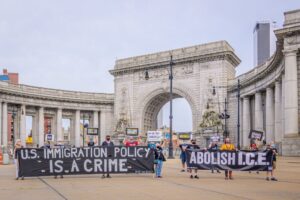Remember when Democrats and progressives claimed the moral high road because they promoted and supported sanctuary cities? Remember when local lawmakers proudly broadcast that they’d welcome all immigrants and refuge seekers? Those sentiments have vastly changed now that their towns and states are being overrun with border jumpers. In fact, a new survey shows that more than 60% of Chicagoans say they think sanctuary cities should be a thing of the past.
Are Sanctuary Cities Becoming Less Popular?
The survey was conducted by M3 Strategies between Oct. 1 to Oct. 3 and included 659 randomly selected Chicago voters. According to the poll, 70% said housing new migrants is negatively affecting current residents, especially those in need. Breaking that down demographically, this included 79% blacks, 74% women, 71% Hispanic, 75% of West Side and South Side residents, and 67% Democrats who agree that supporting migrants is hurting Chicagoans.
Half of the participants felt that migrants are making the Windy City less safe, and only 39% believe Chicago should remain a sanctuary city. It’s no surprise people are not as supportive now that their neighborhoods are being overrun by illegal immigrants. Mayor Brandon Johnson, who once advocated for safe places for migrants, is barely keeping his head above water trying to find housing and money to support them.
It’s easy to advocate for something when you only have half the picture or it isn’t affecting your life personally, as many lawmakers are now realizing. “Now, these politicians are abandoning the virtues they were so proud to signal before they realized the disaster these policies wrought,” Jason Johnson, president of the Law Enforcement Legal Defense Fund, told The Center Square.
FAIR, a website dedicated to “restoring common sense” border controls and immigration policies that work, writes that there are around 600 sanctuary jurisdictions across the country. Let’s take a look at some of the top sanctuary cities and their statistics:
New York City, New York

(Photo by Erik McGregor/LightRocket via Getty Images)
The Big Apple is the largest and one of the oldest sanctuary cities. In 1989, then-Mayor Ed Koch (D) signed an executive order that prohibited disclosing information about immigration status if the individual “is suspected … of engaging in criminal activity,” FAIR explained. More than 118,800 migrants have sought refuge in NYC since the spring of 2022, and approximately 36% of the population is foreign-born.
Migrant crime: In 2020, a 92-year-old Dominican immigrant, Maria Fuertes, was brutally raped by a Guyanese illegal alien. The suspect had been in police custody in November 2019, accused of assaulting his father. ICE requested that he be detained, but local authorities ignored it and set him free.
Mayor Eric Adams has backpedaled on his stance about illegal immigration, recently saying: “This issue will destroy New York City.”
Chicago, Illinois
In 2006, Chicago lawmakers adopted the City Council Welcoming City Ordinance, and then-Mayor Rahm Emanuel expanded it in 2013 so that illegal aliens could only be detained under “very limited” circumstances. Basically, they had to be convicted of a serious crime. According to a report by Vera, 1.7 million immigrants live in the Windy City, about 18% of the population.
Migrant crime: After a Mexican suspect in the country illegally was arrested for theft in 2019, he was released and allegedly went on to sexually assault a three-year-old girl in 2020.
San Jose, California
San Jose became a sanctuary city in March 2007. In 2011, Santa Clara County, as well as hundreds of California cities, started refusing to hold non-citizens in jail until immigration agents could place them in custody. As of 2022, immigrants make up 39.1% of the population in the city, according to San Jose Spotlight.
Migrant crime: Resident Bambi Larson was murdered in 2019 by a Salvadoran illegal alien and gang member who had been freed multiple times.
San Francisco, California
 The City by the Bay reached sanctuary status in 1989 after it adopted Chapter 12H of its administration code, affirming San Francisco as “a City and County of Refuge,” virtually prohibiting immigration officers from detaining illegals. Mayor London Breed says on the city’s official website that “we are a sanctuary city, now, tomorrow and forever.” Immigrants make up roughly 36% of the city’s population.
The City by the Bay reached sanctuary status in 1989 after it adopted Chapter 12H of its administration code, affirming San Francisco as “a City and County of Refuge,” virtually prohibiting immigration officers from detaining illegals. Mayor London Breed says on the city’s official website that “we are a sanctuary city, now, tomorrow and forever.” Immigrants make up roughly 36% of the city’s population.
Migrant crime: On July 1, 2015, Kate Steinle was murdered by a Mexican illegal who had been deported five times prior to the crime.
A Nationwide Problem
As President Joe Biden’s near-open border policies have allowed millions of illegal border jumpers into the country, lawmakers and citizens are beginning to realize offering sanctuary with benefits usually reserved for citizens just might not be the right way to go. Chicago Rep. La Shawn Ford, a Democrat, told The Center Square, “What people are feeling is that the people who have been in these neighborhoods for generations, they have been treated inhumanely by the same government that is making efforts to provide good care to the asylum seekers.”
Johnson said: “The plain truth is that sanctuary city policies hobble law enforcement’s ability to protect the public from dangerous criminals.” He added:
“Unlike American-born offenders, authorities almost never know the true criminal histories of illegal alien offenders who previously committed crimes abroad because their home countries don’t have or don’t provide their records to American law enforcement.”
Ken Oliver, an immigration expert at the Texas Public Policy Foundation, said citizens of these cities are becoming more aware of just how much it costs to house the immigrants, at the expense of residents. “What we’re seeing is a backlash that is growing and well justified,” he explained to The Center Square. He added: “That backlash and the budgetary realities facing cities and states at the receiving end of the Biden border crisis are driving a new and welcome trend. It is fitting that the unwinding of unsustainable sanctuary policies is beginning in America’s leading sanctuary enclave of New York City.”
Will this trend catch on and grow? Oliver seems to think so:
“That pressure to unwind sanctuary policies is not only going to continue to build throughout the country, but should also trickle up in the months and years ahead to spur the reversal of the federal policies that created the crisis in the first place.”

